Introduction
The term artistic research goes down easy. It has been coined in the frame of institutions of higher arts education, then some protagonists remembered that a reference to knowledge production is not unusual for some artists and with the inclusion into curatorial concepts it finally has become mainstream at least since Carolyn Christov-Bakargiev as the director of documenta 13 in 2012 claimed that the exhibition should be dedicated to artistic research. Accordingly it is about time to shake it a little bit and to ensure, that art making is in the focus.
This presentation tries to ask, if the term research really holds in the context of the arts. The way it is used and argued publicly calls for a moment of reflection, to see if the term is strong as it is, if it needs new filling or if we should abandon it and seek new descriptions for the complex relationship between art, knowledge and world.
References are made to Fine Art, but some of the thoughts can probably be transferred to other disciplines, like the performing arts. In the end however, every discipline will need its own discourse, to strengthen its own identity.
This presentation is divided into six parts. Part One asks, why we are talking about artistic research. It includes the attempt of a brief overview over the development of academies, art schools and institutions of Higher Arts Education in relation to the idea of research. Part Two tries to cast a light on the discussions in Germany, which are a bit different and which could be characterised by a combination of refusal, denial and enthusiasm. Part Three attempts to describe the difference in the funding of art making and the funding of researching. Part Four compares some artistic practices and the practice of researching while part Five tries to help to understand why curatorial practice has developed such an affection for artistic research. Finally part Six lists a few warnings, gaps, traps and dead ends when artists turn to a formalised acknowledgement as artistic researchers and sketches a few strategies which we might want to keep in mind to ensure, that artistic research does not become a hollow phrase or an activity, which alienates artists from what they have originally set out to do: making art.
References are made to a number of video-quotes and images which are available via various Internet sources. Where possible URLs are given.
Artistic Research, Academies and Institutes of Higher Art Education
When referring to the discussions of the past 10 to 15 years one could think, that artistic research would not exist, if it would not be a fundamental concern of institutes of higher arts education. But artists tendency to compare themselves with researchers and researchers tendency to compare themselves with artists is much older. It is probably only since the fight for funding has grown into a survival struggle, that artists and researchers have become officially divorced.
An early protagonist of a strategic alliance between artists and scientists, and a form of research done by artists is the Center for Advanced Visual Studies at the MIT in Boston. The Center for Advanced Visual Studies is a community for contemporary art, it claims. It was established in 1967 at the Massachusetts Institute of Technology and has been conceived as a fellowship program for artists. (http://cavs.mit.edu) In a brief history it says:
„CAVS has a long tradition of organising public forums for the discussion of issues related to contemporary art and society. The first such event, a “Symposium on Science and Art,” was presented in March 1968 in conjunction with the joint dedication of the Center for Advanced Visual Studies and the Center for Theoretical Physics.“ (http://cavs.mit.edu/MEDIA/CenterHistory.pdf)
„With the founding of CAVS he sought to bring about the “absorption of the new technology as an artistic medium; the interaction of artists, scientists, engineers, and industry; the raising of the scale of work to the scale of the urban setting; media geared to all sensory modalities; incorporation of natural processes, such as cloud play, water flow, and the cyclical variations of light and weather; [and] acceptance of the participation of ‘spectators’ in such a way that art becomes a confluence.” (http://act.mit.edu/cavs/history/)
In a video document from 1972 (https://www.youtube.com/watch?v=Iie6JM2yBpA) György Kepes talks about life as it is and life as it could be. „ There is a discrepancy between life as it is and life as it should and could be. But most of us are confident in life and try to bridge the gap. Artists are among those who have a passionate completeness of life. Today one does not have to have too much imagination or extra sensibility to see how our urban life that we have created for ourselves is not living up to its potential.“
Gyorgy Kepes
"Essentially what I feel is that the public-artist and scientist, too-have lost the ability to communicate with each other. What I'm interested in is how we reestablish communication of ideas.
In 1974 Kepes was followed by Otto Piene as director and Krzysztof Wodiczko was director of the Center from 1994-1996 and from 2004-2008. One of the Center’s most ambitious undertakings under Piene was Centerbeam, a massive multimedia structure that was commissioned in 1977 by Documenta 6, Kassel, Germany, and mounted for a second time on the National Mall, Washington, D.C. in 1978. 18 artists collaborated and many MIT scientists and engineers had been involved. "Centerbeam was a massive, temporary installation of kinetic, performing and participatory sculpture. It incorporated technologies pioneered by CAVS fellows as artistic media: laser projections, holograms, steam screens, neon, video, inflatable sculptures helium-lifted into the sky and other works, projected from the spine of a 144 foot long water prism. The rational, processional form of Centerbeam by day and its indeterminate volumes of laser-illuminated steam, floral and stellar images by night, embodied CAVS’ symbiosis of the arts, sciences and engineering.“ Light, energy, new technology has been the kernel of many artworks in collaboration between artists and scientists and as research of that time.
Otto Piene: "centerbeam" at documenta 6, 1977
still from "anemic cinema", Marcel Duchamp, 1926
In the Renaissance artists started to proclaim that painting is based on geometry and mathematics. Anatomy studies were a precondition to picture reality or history. Accordingly a kind of curriculum was developed, overriding the safely protected secrets of the guilds. At the same time the recycled idea academy was a welcomed opportunity to come together and indulge in intelligent conversations. Universities were not interested In the arts. Art was seen as a developed form of craftsmanship. Artists themselves had to prove, that they also had brains, which would improve their status significantly. Noble families gathered intellectuals, collected intellectuals, to promote their own cultural mind. Understandable that Artists wanted to be among such collectables, as it promised a more comfortable life, than one could have in a guild, if one found a place at a court or a merchants home at all.
Agostino Neneziano, Baccio Bandinellis "Academy" in Rom, 1531
Jörg Immendorf: "Cafe Deutschland IV", 1978, Oil on canvas, 282 x 330 cm, Collection Garnatz
Several etchings from the 17th century give insight in the curriculum ideas of early academies. Obligatory studies of anatomy came very close to studies in medicine. The detailed exploration of the parts of a human body in isolation should enable artists to put a right picture back together and in new ways, like research, Early artistic research.
Then Life drawing started to replace the detailed anatomy studies. And Life drawing classes were the backbone of academies for centuries. The intellectual argument has become a substantial element of every Higher Arts Education curriculum ever since. The mixture of doing and reflecting has become central to art schools. Craftsmanship should be seen as a knowledge of doing, and debate, art-thinking, is to ensure that art making is more than doing. It proves to the world how much art and artists value for society.
staff assessment debate at Glasgow School of Art ( 2007)
Raphael: "The school of Athens" (1509 - 1510)
Kunstakademie München 1909
A nicely rounded system, with clear conformity to itself and usually quite convenient and loved by those who benefit from it. In some instances a highly successful model. The very close relationship between individual students and professor often is the fruitful ground for new cultures to emerge. Sometimes though it can lead to very suspicious forms of reproduction and in the worst case it can lead to a very unhealthy form of neglect.
The story of art and research has been told many times. it still is worth looking at it again from the various angles of the slightly different pace of developments in the conditions of Higher Arts Education in Europe and beyond. It has been an aim for artists to be accepted as much more than just craftsmen, who can provide beautiful pictures or objects. Consequently artists have always played with the image of an intellectual. Accordingly the idea of research has been an interest of artists for quite a while. This has been (and is) an Individual interest which produces individual solutions, often very exciting solutions and sometimes very exciting art works.
The institutional interest for research experienced a complete new drive in the end of the 20st century- It started with the remodelling of the UK system of Higher education. In the 70ies art schools in the UK moved away from awarding the diploma in Art and Design towards a Bachelor of Arts. At the same time many former independent art schools entered the system of Polytechnics, in a way a raise of status. In the 90ies polytechnics had become universities and most art schools were now part of universities, fully accepted alongside all intellectual education. Universities however were funded in two (now three) strands: Learning and teaching, now also knowledge transfer, but most importantly: research. This brought the necessity to art schools to consider research as a substantial part of the academic life and it also created the task to generate income through research. Since 1986 the Research Assessment Exercise (now the Research Excellence Framework) has become the quinquennial milestone or the nightmare for every UK art school to prove its value through research. It became vital to apply to the Art and Humanities Research Board and since 2005 to the AHRC (Art and Humanities Research Council) for the funding of research as this indicates accepted research quality. Research qualifications are a better prerequisite for funding success at the AHRC. So PhD programmes emerged everywhere in the UK and are now a robust part of HAE in the UK.
Towards the late 90ies the developments in the UK created curious interest in the Scandinavian countries. Kunstnerisk Utviklingsarbeid or artistic development was of interest to artists and art schools alike. But the dependence on a rigorous funding system like in the UK frightened and should be avoided. Norway moved to the Stipendprogrammet, Providing funding for selected artists and their projects connected to any of the Art and Music schools in Norway for the first time in 2003. The interest centred around content and came from the inside of the art schools.
Art production has changed fundamentally and so have the roles, that artists take. The Stipendprogrammet does not lead to a degree. A PhD can be seen as the title that easily signifies comparable excellence. But it also could mean to enter a conflict with those providing and safeguarding the long history of science, research and researchers. A PhD is certainly a qualification. It labels that someone can do research, not necessarily that someone does or has done interesting research, not to speak about exiting art. Other Scandinavian countries moved along as well. Finnland and Sweden now have established and well recognised research programmes for Art and Design and in both countries successful PhD programmes are established.
The Bologna process accelerated the discussion on research and research degrees considerably. The path from a two cycle system to a three cycle system is short. The two cycle system has been established nearly all over Europe for art schools. This was a survival necessity, when in many countries, especially east European countries, the argument for the public funding of Higher Arts Education had to be renewed. Many art schools across Europe offer PhDs now. The latest consequence of this is that Romania and Bulgaria are the first countries, where a PHD is a condition for teaching at an art school. Just being an excellent artist is not enough any more.
I think this would be a good moment to reflect once again what originally motivated artists and art schools to get involved with research in the 20th and 21st century. We should not deny that it is about status of the institutions, about equal ground to work with science, about comparability of excellence through the PhD degree. But the most important driver is the certainty that art making can very well produce new knowledge. It always has. Art is no better or worse than what science does. Art can be an important contribution to the development of our society, socially and culturally.
German art schools continued to concentrate on the idea of Academy. Students work with artists and focus on their own work which is presented annually to a wider public. The public is delighted and stands in line to visit the annual show. An art school like the Kunstakademie Düsseldorf considers it as an indicator for quality, that about 40 000 visitors come to the school to see the show in just one week. Other art schools outside Germany can point to similar public interest.
Visitors queing for "Rundgang" at Kunstakademie Düsseldorf
Degreeshow party 2007 at Glasgow School of Art
Today PhD programs grow everywhere. It seems to become a natural consequence, that the terminal degree for an artist is a HhD, at least if she or he wants to teach at an art school. In a good way, we can observe a shift of paradigm. Art making has changed and accordingly Higher Art Education has to change. Or has HAE changed and this way has a good or bad influence on art making?
The intense research debate all over Europe and other parts of the world did not have an effect on German art schools. Peers are sought in the field of the international exhibition circuit and the art market rather than among other art schools let alone in science. After all: the climate is formed by artists who thrive well and successfully in such a surrounding. Accordingly the press enjoyed publishing with a tendency to ridicule.
A leading argument came from Peter Geimer, Professor for art history at the FU in Berlin. „All the fuz about artistic research.“ In the article Geimer argues that the art / science hybrid as it appears now is too indecisive for the arts and of very little relevance for science. He would rather see something new: an unexpected amalgamation of art and science. He is afraid that the current attempts restrict art making to a method of problem solving, which could be evaluated, also with the criteria in mind, which are familiar to the world of science. Art cannot solve problems. Geimer paints a picture of artists with success in acquisition of third leg funding, rather than gaining for the highest expertise in their fields. He suggests to insist on difference, Art is different and should act different - not being exclusive, but difference in a sense of diversity and a condition to be able to cross boundaries The final sentence of his article translates somewhat like this:
„…insisting that art is different is not an expression of a romantic art understanding, which would define art just as the reservoir of beauty, sensuality and irrationalism. On the contrary art is very rational. ..... Art constructs differences and differs from other functional systems of society. ... Insisting on art being independent and different would still be a better choice rather then assimilation and mimicry of research policies.“
Peter Lynen, former administrative director of Kunstakademie Düsseldorf and a specialist in art related law is another important voice in this discussion. He reminds German colleagues that Science and Art are seen equal already on legal and constitutional terms. Leaning towards the jargon on conditions from research as it is known by science would be a significant step backwards. Instead it is now time to claim substance in the opportunities for funding and support which on legal terms already exists.
The rectors of the German art schools have therefore started in 2011 to investigate different models, which would support the arts and specific forms of art making, without changing language (and as a consequence inner attitude) to adapt to the jargon of science and or humanities.
Also in Germany some schools could not resist. The academy in Hamburg offers a doctor in artibus and the Bauhaus Akademie in Weimar offers a PhD. in both cases the expectation is a fifty / fifty split: 50% Dissertation and 50% art work. The experience is not always positive. Like everywhere else there are not that many double skilled people.
Consequently one struggles with a lack of competence on both sides. Candidates are not prepared well enough to write a dissertation which would hold scientific standards or is of interest for anyone else than the candidate him- or herself. Unfortunately the programmes so far also rarely lead to really inspiring artworks or artists.
A different model is run by the university of the arts in Berlin. They started a Graduiertenkolleg and a graduate school as a double act. The „Kolleg“ collects scientists and junior scientists under a thematic umbrella: „Das Wissen der Künste“, The Knowledge in Arts. The graduate school offers places (nicely supported with a grant) for selected artists, that have experience or intentions in working with scientists in the widest sense. Selection is strictly project based and highly competitive, but always art centred. The school currently names 15 fellows, as they are called. Fellows are supervised or guided by a team composed from the group of professors of the UDK. This team is further boasted by so called senior fellows, who for a limited amount of time get connected to the Graduiertenschule, artist like Tino Seghal
or Ai Wei Wei. Despite the intended link to science the emphasis is on art making and the contribution to knowledge which stems directly from that. The result is artwork, no dissertation. The model reminds me of the MIT model and György Kepes’ Center for Advanced Visual Studies from the early 70ies.
Joseph Beuys, 1977, Postkarte, 14.8 x 10.5 cm, Edition Staeck
Funding Maelstrøms
Funding often is the generator, at least the accelerator, for artistic research and for art making as well. Artists come to art schools to work with art and art students. We try to transfer or resemble studio practice, as we know it, to a teaching practice, usually with some success. Especially when a community aspect is added and group dynamics enhance individual studio practice. Art Schools however are publicly funded, or at least subsidised. In the UK funding is allocated for learning and teaching, for research and for knowledge transfer. Income generation has become a task also for individual artists, who just wanted to discuss art making with art students. Third leg funding, in a climate of full economic costing, includes substantial overhead costs, which are in the end essential for the institution. This is calculated through a form of assessment. So artists have to prove that they are research active. The best way to prove to be research active is to produce evidence of successful project funding and artists at art schools spend a significant amount of time to apply to funding councils.
Artists make art, that is what they are best at. Art making costs money. So artists apply to art councils for funding and compete with other artists. We try to be strategic and apply for what we think might be successful, rather than what we think would produce good art. Councils fund exhibitions, performances, concerts, which is the final product. Exceptions are residencies or commissions. Artists normally have to find their own way, to fund themselves for the period of development and making. Research councils however try to provide scientists with funded time, to do the research.
Kunstmarkt Cologne, 1967
The idea of Art Market stems from the 60ies. September 12 1967 was the date for the first art market. It happened in Cologne. A few selected Galleries joined forces to bring collectors closer to the idea of buying contemporary art. They left the intimate aura of the one on one sales talk in galleries and opened to more competition and a wider public, This developed into ART Cologne, with a number of ups and downs, but now back as an influential international event. The model was successful - easily to be followed if you watch the development of prices for artwork- and in 1969 the Art Basel took place for the first time. It now is an important force with international branches in Miami and Hong Kong. Also galleries spread their branches world wide. But of course, not every artist benefits from or feels comfortable with such a thriving international business.
Bob & Roberta Smith (alias Patrick Brill), 2009, Tate Triennial, , Altermodern, Nicolas Bourriaud
Artists always had a tendency to mirror or mock strategies and practices known from or assumed as typical for the research that scientists would do, from renaissance to impressionism and pointillism. But also in contemporary art making the idea of „laboratory“ is attractive for many artists, maybe because it promises an atmosphere of freedom, determination and focus.
Marko Pehljan, Macrolab, 1997-2007
Mark Dion examining specimen, 2007
The relationship artist and labs is probably demonstrated best in the artists in labs program, a collaboration between the Zurich University of the Arts (ZHDK), the Institute for Cultural studies in the Arts and the federal office of Culture in Switzerland. The program fosters „more collaboration potentials between artists and scientists and offers artists the opportunity to deepen their own research through an increase in scientific understanding in nature, phenomenon, perception, data analysis and interactive relevance.“ In return, it „gives scientists the opportunity to learn more about art….“. The most prominent partner of the artists in labs program is probably CERN, The European Organisation for Nuclear Research, recently in the headlines, as they could through their extravagant experiments could prove the existence of the Higgs Boson elementary particle. In 2009 Christain Gonzenbach took residency at CERN, with the attempt to make sculptures out of dark matter. Although his experiments certainly failed his residency made CERN to establish even more cultural engagement and engagement in and for ART. With a cultural advisory board they created Arts@CERN and Collide@CERN (in collaboration with ars electronica.) Julius von Bismarck, the winner of the first ars electronica Collide @CERN prize stated: “The root reason why I am an artist is the same as it would be for being a scientist: finding out what there is out in the world and how I can contribute to our understanding of it. I am interested in making science sense-able – through the body and its senses…”
Roman Signer, Office Chair 2006
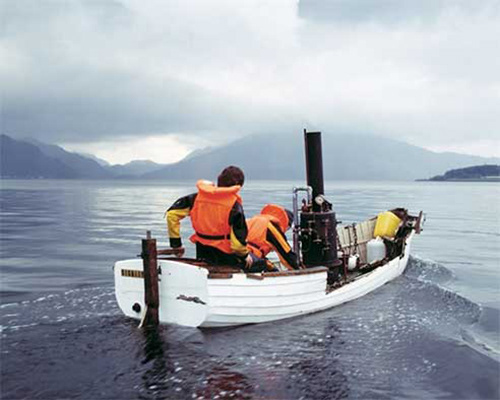
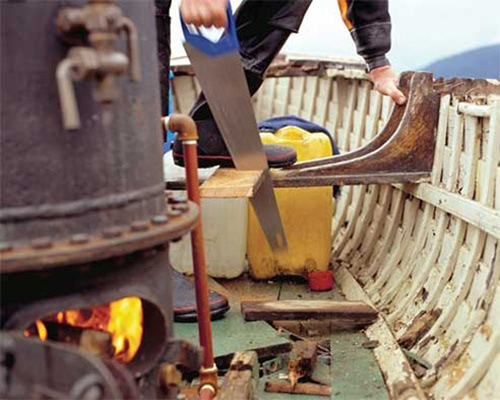

Matt Mullican, Untitled, 1973
Matt Mullican: entering the picture ,entrance to Hell‘, 1976
Nam June Paik: Good morning Mr. Orwell (1974) (Beuys)
Nam June Paik: Good morning Mr. Orwell (1974) (John Cage)
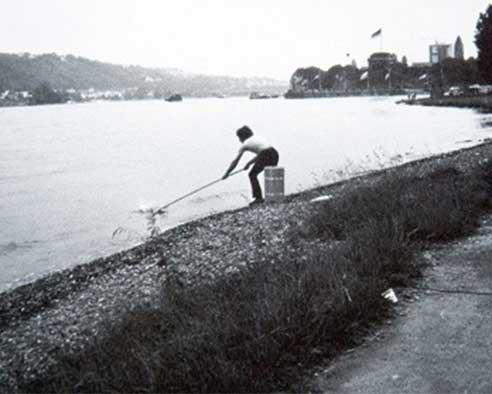

Catherine Yass: High Wire, 2007
Thomas J. Cooper"uncharted dangers" clear, collection Lannan
Thomas Joshua Cooper, The Denmark Strait, Lannan Collection
Anselm Kiefer, Nero Paints, 1974
Andreas Siekmann, The Treuhand and the Invisible Hand (detail), 2005–2008
Andreas Siekmann: "Die Exklusive – Zur Politik des ausgeschlossenen Vierten", 2007

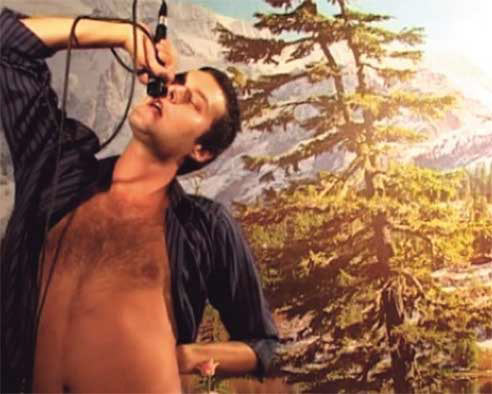


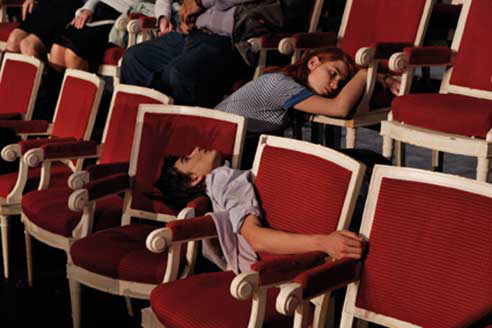
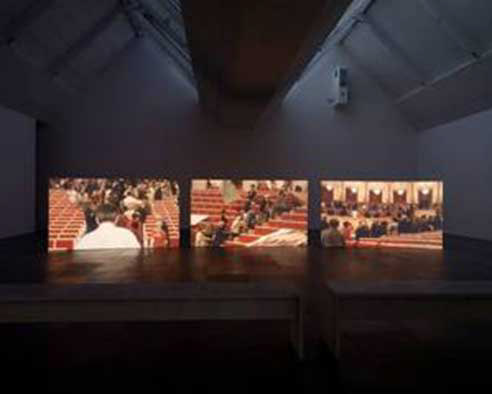
All such examples of art work relate in one way or the other to science and research. But all conclude in an art work. Science and research do not need to be in the foreground. No research training was necessary. This way the knowledge produced is so fresh and really enriches our knowledge that is produced by research following the research rules. Both, scientists and artists seem to be equal in attempting to produce a picture of the world. It is since the enlightenment and since Newton that human minds were liberated from the dictate of Bible and church, to try to see and understand world with our own eyes and as it is or at least as it appears. New models of the universe followed Newtons discovery and theory.
Matt Mullican: "Organising the World", Haus der Kunst München, 2011
Piero Manzoni: "Socle du Monde" (Base of the world) (1961)
Ross Sinclair: "Real Life", Duff House, 2000
Joseph Beuys: "7000 Eichen", 1982
Willie Doherty: stil from "Re-Run", 2002
Curators research
So much for artists, and their relationship to research or how they produce knowledge, without leaning towards the scientifically accepted research strategies. But there are other agents in the field of the arts. Also curators research. Maybe even more than artists, at least with more consciousness.
Ars Electonica centre
Ars Electronica Futurelab Academy
reconstruction of Francis Bacon's Hugh Lane studio from London to Dublin
The role model for all curated international shows certainly is still the documenta.. The first documenta took place in 1955 under the direction of Arnold Bode. In a climate of the cold war, at that time Kassel was very close to the border of the DDR, he attempted successfully to rehabilitate what under the fascist regime of the Nazis was labeled and persecuted as entartete Kunst (degenerated art). Since the then documenta took place every 4 years and became a milestone in the contemporary art circus. Since 1972 and the documenta 5 every documenta had a new artistic director. Budget and visitor success increased from documenta to documenta. D10 from 1997, directed by Cathrine David had a budget of 22 million DM (11 Million €) and attracted 630 000 visitors. D12 from 2007, directed by Roger M. Buergel had a budget of 27 Mio € and attracted 750 000 visitors. D13 is directed by Carolyn Christov-Bakargiev, Born in the US in 1957, with Italian roots and an Italian citizenship, senior curator at the PS1 in New York, and since 2009 director of the Castello di Rivoli in Torino. This year the budget is estimated at 25mio,- € and the organisers hope for 1mio visitors.
Occupy activists at dOCUMENTA (13), photo: Uwe Zucchi
The first encounter with d13 reveals the following: dOCUMENTA (13) is dedicated to artistic research. The notion „artistic research“ has quietly (or with significant noise) entered the public domain and from now on, critics might not dare to question what that should be, artistic research. Or will they? About 4 years ago, when I read the description texts to art works in an exhibition in Sweden, and every text started with: this piece is a result of artistic research I felt quite uncomfortable. Now, this is the official tone?
To be fair: the introduction text by CCB continues: “dOCUMENTA (13) is dedicated to artistic research and forms of imagination that explore commitment, matter, things, embodiment, and active living in connection with, yet not subordinated to, theory. These are terrains where politics are inseparable from a sensual, energetic, and worldly alliance between current research in various scientific and artistic fields and other knowledges, both ancient and contemporary. dOCUMENTA (13) is driven by a holistic and non-logocentric vision that is skeptical of the persisting belief in economic growth. This vision is shared with, and recognizes, the shapes and practices of knowing of all the animate and inanimate makers of the world, including people. (C. Christov-Bakargiev)
Chuz Martinez, a spanish curator born 1972 and a member of the documenta team contributes to the Book of Books (the 80 pages strong textbook accompanying the show) with an essay titled Unexpress the Expressible with the core line: „art is thinking but is not theory.“ She later on refers to inquiry, rather than research.
When we enter the Fredericianum, the main exhibition building, we are greeted by two large empty rooms. And we feel air, not just hot air, but cold air. Fresh air? A gentle breeze, produced by invisible ventilators, a draft embracing the visitor. one of three subtle pieces by the english artist Ryan Gander (born 1976) I need some meaning, I can memorise (the invisible pull) (2012). This is the vestibule to the „brain“, the rotund where once Beuys centred his honey pump. It now is an „associative space of research, where a number of artworks, objects and documents is brought together in lieu of a concept.“ For example Man Ray objects, bathroom articles from Hitler‘s bathroom or an excerpt from a video by the egyptian artist Ahmed Basiony shot on Tahir Square on January 25 2011, On January 28 Basiony died of gunshot wounds inflicted by the egyptian police force.
CCB showed a level of consistency, when including real live scientists, real live researchers, such as Anton Zeilinger, the leading quantum scientist, born 1945 in Austria. He demonstrates and explains quantum physics and his theories to the art audience and the lab apparatus is set up in the gallery.
Anton Zeilinger demonstrates the worldwide first quantenkryptographic banktransfer (2004), photo: Heinz-Peter Bader/Reuters
The wish to heal streams from a quite a few projects. Maybe a helpless and useless, but desperate attempt of artists in a quest to matter. Like Pedro Reyes Sanatorium, which offers 8 different therapies to stressed urban art lovers. Pedro Reyes is Mexican, born 1972.
Pierre Huyghe at dOCUMENTA (13)
Susan Phillipsz (1965, Glasgow) has chosen a hidden place for her work, extracting some of its history and returning meaning to it. A number of invisible speakers mounted at the end of the hardly used railway station emit at certain times a string concerto. This in itself adds a very special atmosphere to the slightly hostile site. But then we learn, that the concerto has been composed by Pavel Haas in 1943 and has been performed at the KZ Theresienstadt, before Haas was murdered in 1944 in Auschwitz., it unfolds its full potential. The Hauptbahnhof in Kassel has been the starting point for many trains deporting Jewish Citizens to concentration camps. Is the combination of facts a result of research? But it culminates in a work of art, with all its openness and uncertainties.
Susan Philipsz, Study for Strings, 2012, Kassel Hauptbahnhof at dOCUMENTA (13), Kassel, Germany., Photo: Emmy Skensved
All of these artworks are based on research, an intense and concentrated period of collecting and comparing information, often underlined by experiments and coming to surprising suggestions. But would any of those artists think of him/ her self as researcher? And: the quality of the work lies in the end in the openness, leaving space for thought, inflicting thinking, provoking or enabling knowledge in an unpredicted way, something that scientists would shy away from.
Traps, Gaps, Dead Ends and Future Strategies
Such thoughts and observations lead me to urgent questions. How can we avoid, that artistic research (if we use the term) is developing in the isolation of the the academic world, lacking contact to the worlds of art and or culture? How do we avoid, that art-making, especially in art schools becomes depending on funding, provided under limited terms? Can we get used to the languages that have a chance to lead to success in application processes? But how can we avoid that changing language changes our minds? How can we avoid that art making as research becomes an instrument for other social or scientific causes, rather than insisting on being radically free? How can we avoid that curatorial research rather than artistic research dominates exhibitions and artistic development? How can we avoid that research is used as means to tame the awkward and unpredictable artist?
I am convinced that art making is very influential to our knowledge and the knowledge of our societies. I am convinced that experiments are crucial for art making of quality. I am convinced that art making must understand and know the context, in which it develops (like science). But with all our attempts to raise the status of art making and with our hopes that the introduction of the term artistic research is a change of paradigms and may lead to new roles we must not stop to safeguard the independence, that all art making needs. We must claim trust in the qualities of art making. Governments should trust artists. And we artists? We should continue to improve our self confidence: which stems from: art making.